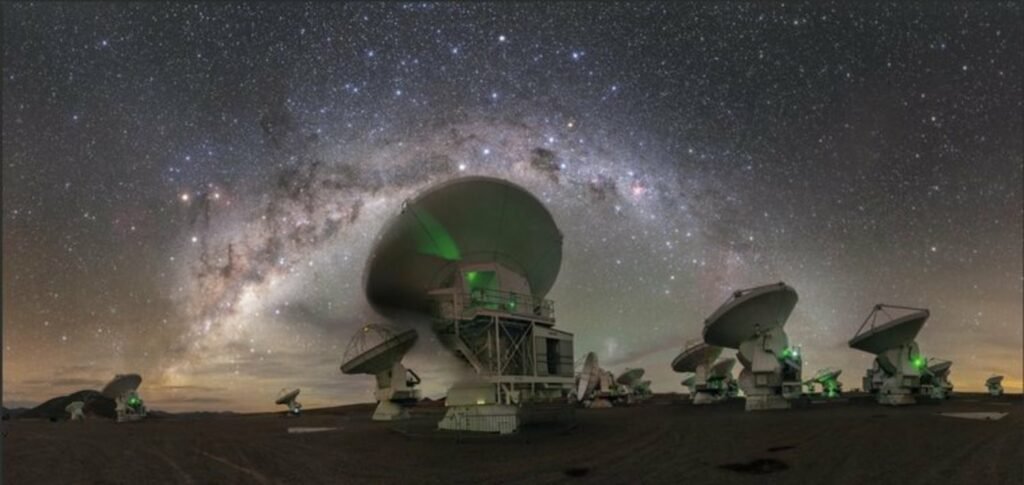Astronomers have discovered a powerful magnetic wind emanating from the luminous infrared galaxy ESO 320-G030, and according to the astronomers who discovered it, a local black hole is using this magnetic wind to grow.
Published in the magazine Astronomy & AstrophysicsThe research provides new insights into how galaxies form and control the growth of their central massive black holes.
Black holes are regions of space where gravity is so strong that nothing, not even light, can escape. They form when massive stars collapse under their own gravity at the end of their life cycle. Black holes with masses ranging from millions to billions of times that of the Sun reside at the centers of many galaxies, including our own Milky Way. They play an important role in galactic evolution by influencing the motion of stars and their surrounding gas.
Enter the magnetic wind; Streams of charged particles are driven by magnetic fields. These interstellar winds are immense streams of gas that can escape from the centers of galaxies, affecting their growth by removing the gas that would otherwise fuel star formation and black hole growth. The origin of these winds is hotly debated among scientists, with theories suggesting that they may be driven by jets from black holes, radiation, or magnetic forces.
But these latest findings indicate that this magnetic wind actually helps these black holes grow.
Led by Mark Gorski and Susanne Aalto, the international team of researchers focused on ESO 320-G030, an isolated galaxy about 36 million light-years from Earth. The galaxy is notable for its compact hidden nucleus, a dense and dusty region that hides the growing supermassive black hole. The team used the Atacama Large Millimeter/submillimeter Array, also known as ALMA, in Chile to observe ESO 320-G030 in unprecedented detail. Its high-resolution capabilities allowed researchers to map the galaxy’s core and its molecular outflow with a resolution of about 5 parsecs (about 16 light years).


„Because this galaxy is so luminous in the infrared, telescopes can resolve the striking details at its center,” explained Susan Aalto, professor of radio astronomy at Chalmers University of Technology. In a press release. „We wanted to measure the light from molecules carried by the wind from the galaxy’s core, hoping to discover how the wind is initiated by a growing, or soon-to-be, supermassive black hole. Using ALMA, we were able to study light from behind dense layers of dust and gas.”
Based on their observations, the researchers concluded that ESO 320-G030’s outflow is driven by magnetic winds driven by magnetic fields rather than feedback from star formation. This finding is significant because galaxies can control their nuclear growth through magnetic processes, similar to the growth of protostars.
In simple terms, it’s like water circling a sink drain around the outer edge of a black hole before material like dust and gas falls out. At the edge of a black hole all matter gathers, swirls around, and is torn apart by its sheer gravity. According to research, this is where magnetic fields form and begin to grow stronger. These magnetic fields help lift some of that debris and push it outward from the black hole, creating a sort of whirlwind of wind. As that wind frees some material from being consumed by the black hole, the violently rotating disk around the black hole loses its intensity and slows down, allowing the rest not 'saved’ by the magnetic wind to fall out. Inside the black hole, it allows it to grow.
The magnetic wind can drag some matter away from the black hole, but as it does, the spin of the black hole’s outer rim slows down, allowing what’s left to fall out. Everyone there is a terrifying centrifugal force frolicking. Its spin pushes it to the outer edge of the ride, but then it slows down, that centrifugal force dissipates, and everyone is sucked into the center of the ride and experiences a terrifying singularity, where their bodies are pulled apart by gravity like spaghetti.
“We can see how the wind from the center of the galaxy creates a spiral system. „When we measured the rotation, mass and velocity of the outflowing material, we were surprised to find that we could rule out many explanations, such as wind power and star formation,” says Aalto. „Instead, the outflow is driven by inflows of gas and held together by magnetic fields.”


Researchers note that this black hole formation is similar to how stars form.
„It is well established that stars grow in the early stages of their evolution with the help of rotating winds accelerated by magnetic fields, just like the winds in this galaxy,” Mark Gorski explained in a statement. „Our observations show that supermassive black holes and small stars can grow by similar processes, but on very different scales.”
The study provides new evidence that magnetic forces can drive galactic winds, providing a new perspective on how galaxies and their central black holes form. The next step is to find other supermassive black holes with this magnetic wind and prove that ESO 320-G030 is not an isolated event.
Now that we know what to look for, the next step is to find out how common the phenomenon is,” Gorski says. „And if this is a phase that all galaxies with supermassive black holes pass through, what happens next to them?”
MJ Banias covers space, defense and technology with The Debrief. You can email him at mj@thedebrief.org or follow him on Twitter @mjbanias.

„Oddany rozwiązywacz problemów. Przyjazny hipsterom praktykant bekonu. Miłośnik kawy. Nieuleczalny introwertyk. Student.
